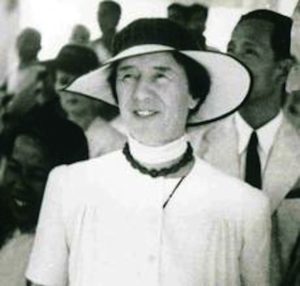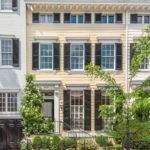Hillandale is one of the only gated communities in Washington DC and was recently hailed in Forbes.com as one of the 9 best gated communities in America! It sits on the former estate of Ann Archbold, who was one of the two daughters of John Dustin Archbold, one of the earliest independent oil refiners in the country and became on the original directors and executives at Standard Oil. Hillandale has a rich and interesting history. It was a working 70 acre sheep farm until Ms. Archbold bought the entire property in 1922. The original villa and gatehouse, still located in Hillandale today, were designed by Ms. Archbold with the help of Josephine Wright Chapman, one of the first female architects in the country. Both structures are now designated Historic Properties.
Today, Hillandale retains the spirit of gracious living envisioned by Ann Archbold when she built her original villa in 1922. Surrounded by the 250+ acre Glover-Archbold Park, Hillandale is a naturally wooded area with ponds, wildlife and a serenity not found in any other location so close to the heart of the city. True to Ms. Archbold’s plans, Hillandale exhibits a lush beauty, interspersed with a bright palette of seasonal flowers and vegetation.
HISTORY As a working farm, the property included mature forests, lush meadows, orchards, rose gardens, a main residence, a stable, a gatehouse and several other small outbuildings. In 1924, two years before her home was completed, Ann Archbold donated 23.12 acres of this land to the DC Park Service to become part of Glover-Archbold Park. Ms. Archbold died in 1968, leaving her home to her son, John Dana Archbold, who used it as his city home. He sold 8 acres in 1973 to the Republic of France to build a Chancery and residence.
In 1978, John Archbold leased 42 acres to Clint Murchison, the former owner of the Dallas Cowboys, to develop a planned unit development, on the condition he retained the 5 acre parcel that held the original mansion and gate house. In 1979, the DC Zoning Commission approved the PUD. However, there were several challenges before the completion of the Murchison-s project.
The Hillandale Development Company was formed and Murchison’s company, Tecon Realty/Development was the contractor. Sometime in 1980, the lease became a sale. Yet after only 54 of the planned 268 townhouses (what is now Georgetown Court) and one detached house were built, the parcel was taken over in a foreclosure action in 1985 and sold to another developer, Wymark. Wymark wanted to convert the mansion into condominiums. This was opposed by the community and area homeowners. Wymark subsequently sold the Mansion and the remaining 1.5 acres to Sur Development in 1988.
Sur Development then proposed razing the mansion and asked the community to suggest appropriate uses for this parcel. Eventually, the DC Zoning Commission approved the Sur proposal to tear down the mansion and build 13 townhouses; but, this decision was opposed by the French Embassy and various preservationists in the community who had seen too many of the city-s historic properties demolished. Ultimately, the Hillandale mansion, unoccupied for over 10 years, was preserved by historic designation in 1995 and divided into two parcels in 1998 and subsequently restored by the two current owners.
Kettler Brothers purchased a large part of the remainder of the Hillandale parcels and built townhouses and most of the detached houses. Two other developers, Otto Schmidt and Alan Kalbalkin, each built several detached homes. The last section of Hillandale was built by Eakin Youngentob on upper Mansion Drive and all of Hillandale Court. Today Hillandale tries to maintain the overall pastoral vision of Ms. Archbold by stringently preserving its Federal design and lush landscaped common spaces.
THE HILLANDALE MANSION
The address of the original dwelling was 3905 Mansion Court. A long driveway ran past the gatehouse and a cherry orchard up to the hill on which the mansion sits today. The house was designed by Josephine Chapman, a highly successful female architect from New York in close concert with Ms. Archbold. The house was conceived and designed in the manner of a Tuscan Farmhouse with hollow terra cotta tile and covered with a stucco finish. The architect carefully planned the vistas from the sprawling rooms, balconies, and loggias to take advantage of the picturesque landscape of the Hillandale estate. She also designed the gatehouse at 3905 Reservoir Road in the same Italianate style. Both properties are now deemed historic after an application to preserve the main estate was filed in 1990 with the DC Historic Preservation review board.
ANN ARCHBOLD
 A look at who Ann Archbold was as a person gives great insight into the origin of the Hillandale community. As the daughter of the founder of Standard Oil, John Dustin Archbold, she grew up in an affluent family with social standing and had both the means and the adventurous nature for travel. She was reportedly one of the first Western women to enter Tibet. Her childhood was spent in Italy and she was educated in both Florence and Paris. She travelled with, and in, the famed literary and artistic circles of the day both in Europe and the States. All of her expeditions were extraordinary for a woman in the early 1900’s. True to form, she married an Irish aristocrat in 1906 and spent her honeymoon on an African safari. After her divorce, she moved to Washington and planned the construction of her dream home that would replicate the Florentine-Italianate style she loved. During her years in DC and up until her death in 1968, Ms. Archbold was an energetic philanthropist, preservationist and active sportswoman. She led scientific and cultural expeditions to Hong Kong, (to fund the replication of a 15th Century Chinese junk), the Spice Islands and Malaysia where she collected plant, botanical and shell specimens. Ms. Archbold used her perch at the Hillandale Mansion as an artistic entertainment venue. In fact, there is a waltz variation that was created in her honor called the “Hillandale Waltz.”
A look at who Ann Archbold was as a person gives great insight into the origin of the Hillandale community. As the daughter of the founder of Standard Oil, John Dustin Archbold, she grew up in an affluent family with social standing and had both the means and the adventurous nature for travel. She was reportedly one of the first Western women to enter Tibet. Her childhood was spent in Italy and she was educated in both Florence and Paris. She travelled with, and in, the famed literary and artistic circles of the day both in Europe and the States. All of her expeditions were extraordinary for a woman in the early 1900’s. True to form, she married an Irish aristocrat in 1906 and spent her honeymoon on an African safari. After her divorce, she moved to Washington and planned the construction of her dream home that would replicate the Florentine-Italianate style she loved. During her years in DC and up until her death in 1968, Ms. Archbold was an energetic philanthropist, preservationist and active sportswoman. She led scientific and cultural expeditions to Hong Kong, (to fund the replication of a 15th Century Chinese junk), the Spice Islands and Malaysia where she collected plant, botanical and shell specimens. Ms. Archbold used her perch at the Hillandale Mansion as an artistic entertainment venue. In fact, there is a waltz variation that was created in her honor called the “Hillandale Waltz.”
She contributed much to the city of Washington including land preservation programs, support for training of the first K-9 and seeing eye dogs in the city, the first occupation therapy clinic and the first maternal care clinics at local hospitals.








